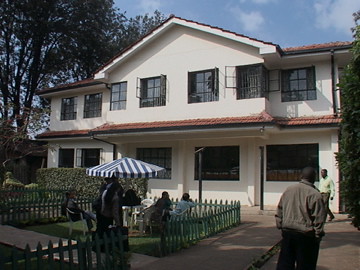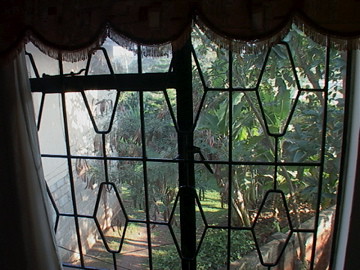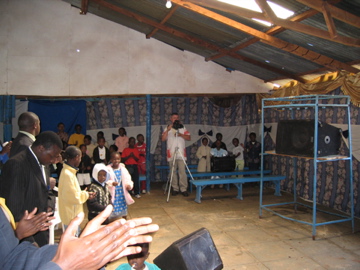
Today is Sunday. I officially started my duties as a mission team videographer this morning by shooting the church service lead by Fr. Dan and Fr. Lawrence. On the way to the church our driver stopped in the center of a small town to wait for another party that would be meeting us. I jumped out of the car and turned my lens on my surroundings. I wanted good shots of street activity for the video but everything I had shot so far was while I was hanging out a car window. Those bumpy shots just wouldn’t do. As soon as I set up the tripod I was mobbed with people. They started spouting off questions as they stared at the camera.
“Why are you here? What’s the camera for? Will you give me money for my picture?”
The crowd grew larger and larger. I began to feel very uncomfortable with all these people pressing in to get closer to me. Fortunately, most of them could speak English, which made the experience a little more bearable. If I hadn’t been able to answer some of their questions, and tell them I worked for the church, the situation would have gotten to the point of me busting out of the crowd and running for the safety of the car.
I’m not sure telling the crowd I was a missionary was a good idea. They started asking me to follow them or if they could show me something somewhere other than right here on the street. Someone in the crowd saw Fr. Dan sitting in the back seat of the car and noticed his Priest’s collar around his neck.
This person yelled out, “He has a Priest with him,” as if I was traveling with the president. The crowd looked at Fr. Dan as if he was some kind of movie star or celebrity. Then they looked at me without the suspicion I saw in their eyes when I first drew attention to myself with the tripod. Now they looked at me as if I was a celebrity too. This new attitude toward the camera and me didn’t help my situation at all. If anything the crowd pressed even closer to me. I finally gave up shooting and returned to the car to hide behind the rock star I was traveling with.
Next stop, the church where Fr. Lawrence had scheduled the mission team to preach and pray for all of those who would come. When we drove up to the building I couldn’t believe we were in the right place. The church didn’t look like a church to me. It looked like a barn you would find on any farm back home. The entire structure was covered in corrugated metal sheets. You know, the kind of corrugated metal used to cover shed roofs or to build small utility buildings. But the garage-like appearance of the church wasn’t the only think making me wonder if I needed my eyes checked. A herd of goats and a few donkeys grazed on the grass right in front of the door to the inside of the church. On either side of the church stood fenced in pens with cows and other livestock milling around in the mud. I even saw a mountain of feed piled up against one of the walls of the church. With all my eyes were seeing, how was I to know a church made it’s home inside this building?
I guess the crowd of nicely dressed people standing in the doorway under a sign with the name of the church painted across it should have tipped me off. I took my camera and tripod inside and thought I had stepped through a hole in reality. I found a fully decked out sanctuary inside the metal building. Up front was a raised platform with a hand made wooden podium at its center. Pots of flowers surrounded the podium and large black speakers flanked both sides of the platform. The corrugated metal walls were hidden behind large curtains made from ornate fabric. In the corner stood a pile of electronic equipment including an audio mixer board and CD players. There was a keyboard resting on a stand and several microphone stands stood guard around the platform. Hidden inside this barn was a contemporary church setup that would rival any church I have attended back home.
The service started with a group of singers taking the stage while a fellow pounded away at the ivory keys on the keyboard in the corner. Man, you talk about praise music that reaches out and grabs your heart. These singers didn’t hold back. They sang from deep down in their hearts and sang with the confidence of seasoned concert performers. I was in the church choir once. I was so self-conscious that I barely whispered the hymns we sang on Sunday mornings. Not these guys. They sang with conviction and continued to sing for as long as the Spirit led them. I didn’t understand the words but I could recognize when they were repeating the chorus over and over again. They closed their eyes and lifted their hands into the air swaying to the rhythm for what seemed like an hour. I rolled as much tape as I could spare knowing I needed a lot of music for the soundtrack to the video. That was some of the best praise music I have ever heard.
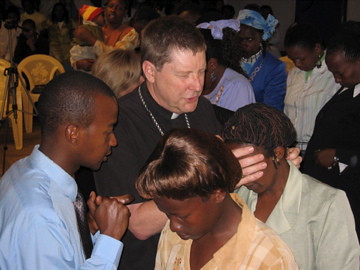
Fr. Dan stepped up to the podium and gave a gripping sermon on the power of prayer and healing. But the most moving part of the service was when the mission team stood in front of the church offering to lay hands on and pray for anyone who needed healing. Once the pastor of the church invited his congregation to come to the alter for the laying of hands, people streamed down the isles to where the mission team stood waiting.
Fr. Lawrence told me after the service that the church had advertised the coming of the mission team from America for over a week. The church was packed to the doors with folks needing prayers. I guessed the church held over two hundred people and there were no empty seats. People stood against the back wall and in the doorway. More than half of these folks surged forward when the alter call came. It wasn’t like those Billy Graham crusades you see on TV. It takes several brave souls to go up front before the crowd finally comes out of the stands. As soon as the call went out people jumped from their seats. No one was worried about being the first person to go up front here.
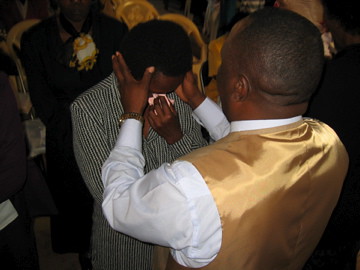
I immediately broke the camera off of the tripod and dove into the crowd to try and capture the emotion flowing down to the alter. Lucky for me, the mission team stood on the floor directly in front of the raised platform. I could stand up on the platform and get in close without invading their personal space. I tried to stay back so that the lens wouldn’t intimidate people or distract them from the reason they were here, seeking prayer. But, I was still in the middle of all the prayers and laying on of hands. I got great shots and good sound for the mission video.
I even shot some still photos to use in the video or the newsletter we send out about our trips. I usually shot to the point to where I feel like I’m repeating shots I’ve already gotten. I decided to back off and watch the praying from the sidelines. Just as I put the camera back into the case, I heard a slap on the concrete floor. I spun around to see that a lady had been slain in the Holy Spirit. She was lying on the floor with members of the team protecting her from being stepped on by the crowd. I had missed the most powerful shot of the service.
I have never experienced being slain in the Holy Spirit so I can’t really describe what it feels like or why you fall to the ground. But, I do know what its like to feel the Holy Spirit working inside of you. When I pray, I speak in tongues like the twelve Disciples of Christ did at Pentecost described in Acts chapter 2 verse 4. I just concentrate on God and imagine sitting before him and saying to him what I would say if he was flesh and I could reach out and touch him. While I’m concentrating on this vision in my mind, my mouth falls open and sounds I have never heard or even thought of making myself flows out. If I quit concentrating on my vision of God and think about the unfamiliar noise rising up from my throat, then the sound stops immediately. I have to concentrate on standing before God or Christ or I will not make the sounds. In my church we call this our prayer language. The only time I have seen Christians in America speak this prayer language was when I attended a charismatic church or a Pentecostal church. In Kenya, every Christian I met spoke in tongues. It didn’t matter if they went to a Presbyterian church, an Anglican church, or a Roman Catholic Church. They all believed in the gifts of the Holy Spirit. I wonder why Americans have to be members of a certain church to receive a universal gift from the Lord?
After the service, the mission team was invited to have lunch with the Pastor’s family in his apartment across the street from the church. Yeah, I know I just described the church as a building surrounded by farm animals. Well, that’s the thing in Kenya. You would see a piece of property that looked like a farm located across the dirt road from a multi story concrete apartment building. No zoning or land use master planning here. It gives new meaning to the American idea of living and working in the same neighborhood.
I got excited when I learned the Pastor lived on the top floor of the building. I needed shots of the typical Kenyan town from above ground level. That way I could show the viewer a birds eye view of the poverty most Kenyans live in. I could show that most of the homes were made out of corrugated metal and that most of the streets are dirt paths with no sidewalks. Being up on a balcony would also keep me from getting mobbed by folks like what happened on the way to church earlier in the day.
When we got back to the home where we were staying, I decided I wanted to shoot one-on-one interviews with each member of the mission team about today’s service and the laying on of hands. I believed that getting their testimony on tape right after the event took place would give me interviews with more detail and more emotion. Time has a habit of fading some of those memories that make for good sound. Each member of the team gave me an emotional story about someone they had prayed over. Some of the people were suffering from illnesses including AIDS, cancer, and substance abuse. Everyone who came forward during the laying on of hands poured out their hearts to the mission team and didn’t hold back on what they were suffering from. Because I was shooting video, I didn’t get to participate in being a part of the group prayer. I actually feel a little left out because I know how powerful and uplifting it can be to pray for someone other than yourself.
I really enjoy praying over others. I know everyone has heard the old proverb that says, “It’s better to give than to receive.” Well, praying for someone gives you a feeling very similar to the feeling you get when you give a gift. I feel like a prayer I pray for someone carries a little more weight than when I’m asking for something for myself. I guess praying for others takes the selfishness out of the thoughts and words you want God to hear. I also believe saying a prayer for someone else strengthens my own faith. When someone comes back to me with a praise report I tend to believe him or her easier than when my own prayer is answered. I know I shouldn’t feel left out of the prayer team because I also have an important job to perform this week.
After two days of travel and two days of shooting, I am already feeling tired and worn down. I thinking I’m getting a headache because I am not drinking enough water. I should sleep well tonight after this long day of working for the Lord.
